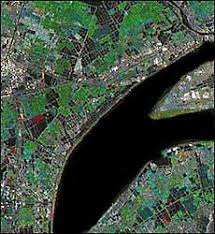Definitions of Land Resources, Land Use and Land Cover
Land is an essential natural resource, both for the survival growth, and development of humanity, and for the maintenance of all terrestrial ecosystems. Over millennia, people have become progressively more expert in exploiting land resources for their own ends.
The limits on these resources are finite while human demands on them are not. Increased demand, or pressure on land resources, shows up as declining crop production, degradation of land quality and quantity, and competition for land.
Attention should now be focused on the role of humankind as stewards rather than exploiters, charged with the responsibility of safeguarding the rights of unborn generations and of conserving land as the basis of the global ecosystem.
Land and its Endowments
Land is not regarded simply in terms of soils and surface topography, but encompasses such features as underlying superficial deposits, climate and water resources, and also the plant and animal communities which have developed as a result of the interaction of these physical conditions.
The results of human activities, reflected by changes in vegetative cover or by structures, are also regarded as features of the land. Changing one of the factors, such as land use, has potential impacts on other factors, such as flora and fauna, soils, surface water distribution and climate.
Changes in these factors can be readily explained by ecosystem dynamics and the importance of their relationships in planning and management of land resources has become increasingly evident.
Definitions of Land Resources, Land Use and Land Cover
Land and land resources refer to a delineable area of the earth’s terrestrial surface, encompassing all attributes of the biosphere immediately above or below the earth‘s surface, including those of the near-surface climate, the soil and terrain forms, the surface hydrology (including shallow lakes, rivers, marshes and swamps), the near-surface sedimentary layers and associated groundwater and geo-hydrological reserve, the plant and animal populations, the human settlement pattern and physical results of past and present human activity (terracing, water storage or drainage structures, roads, buildings, etc.) (FAO/UNEP, 1997).
Read Also : Advantages and Disadvantages of Sanitary Landfill
Land Use is characterized by the arrangements, activities and inputs by people to produce, change or maintain a certain land cover type. (Di Gregorio and Jansen 1998). Land use defined in this way establishes a direct link between land cover and the actions of people in their environment.

Land Cover is the observed (bio) physical cover on the earth’s surface (Di Gregorio and Jansen 1998)
Functions of Land
The basic functions of land in supporting human and other terrestrial ecosystems can be summarized as follows:
A store of wealth for individuals, groups, or a community
Production of food, fibre, fuel or other biotic materials for human use
Provision of biological habitats for plants, animals and micro-organisms
Co-determinant in the global energy balance and the global hydrological cycle, which provides both a source and a sink for greenhouse gases
Regulation of the storage and flow of surface water and groundwater
Storehouse of minerals and raw materials for human use
A buffer, filter or modifier for chemical pollutants
Provision of physical space for settlements, industry and recreation
Storage and protection of evidence from the historical or pre-historical record (fossils, evidence of past climates, archaeological remains, etc.)
Enabling or hampering movement of animals, plants and people between one area and another
In the terminology of environmental economics, land can be regarded as a stock renewable resource. Land resources do not easily fit into the categories of renewable or non-renewable.
In general, they are slowly renewable; however, their rate of degradation far exceeds their natural rate of regeneration. In practical terms, this means that land that is lost to degradation is not naturally replaced within a human time frame, resulting in a loss of opportunities for the next generation.
Land, Population and Management Strategies
The potential production of arable land and its susceptibility to degradation are dependent on the management strategies employed and on inherent soil and other characteristics.
In agriculture- dependent societies this combination of factors determines potentially the population that can be supported and the standard of living.
When population increases in a given area, the increased demand on production can induce stress and consequent degradation of the land resource.
If no other source of income can be tapped (e.g. by migration to urban areas) people’s standards of living decrease.
However, if improved management strategies (including technologies) are available, either the standard of living may rise or more people can be supported at the same standard of living without deterioration of the natural resource base.
It follows that an ample supply of land of suitable quality and appropriate production technologies are essential if the increasing demands of a growing population are to be met.
Availability of Land
Land is not evenly distributed either between countries or within countries, and the difference in access to land relative to population need is more significant than global totals.
Land is becoming more and more scarce as a resource, and this is particularly true of land available for primary production of biomass or for conservation related purposes.
Competition for land among different uses is becoming acute and conflicts related to this competition more frequent and more complex.
This competition is often most apparent on the peri-urban fringe, where the continuing pressures of urban expansion compete with agricultural enterprises, and with recreational demands.
Such situations frequently lead to rapid increases in the economic value of land, and land tenure becomes an important political issue.
Many factors associated with global change directly or indirectly influence how land is used. These include biophysical influences, such as changes in climate or natural or human-induced disasters, as well as socio-economic aspects such as trade liberalization, the globalization of markets, decentralization of decision making, privatization, and the widening gap between the “haves” and the “have-nots”.
In summary, land resources do not easily fit into the categories of renewable or non-renewable. Land serves as a storage and protection of evidence from the historical or pre- historical record (fossils, evidence of past climates, archaeological remains, etc.).
Changing one of the factors, such as land use, has potential impacts on other factors, such as flora and fauna, etc.
Read Also: Top Wastewater Management Companies in the World
Land encompasses such features as underlying superficial deposits, climate and water resources, and also the plant and animal communities which have developed as a result of the interaction of these physical conditions. Land is a store of wealth for individuals, groups, or a community.


